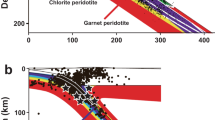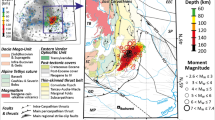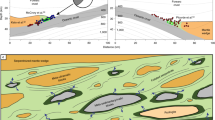Abstract
Earthquakes are observed to occur in subduction zones to depths of approximately 680 km, even though unassisted brittle failure is inhibited at depths greater than about 50 km, owing to the high pressures and temperatures1,2,3. It is thought that such earthquakes (particularly those at intermediate depths of 50–300 km) may instead be triggered by embrittlement accompanying dehydration of hydrous minerals, principally serpentine1,2,3. A problem with failure by serpentine dehydration is that the volume change accompanying dehydration becomes negative at pressures of 2–4 GPa (60–120 km depth), above which brittle fracture mechanics predicts that the instability should be quenched4,5. Here we show that dehydration of antigorite serpentinite under stress results in faults delineated by ultrafine-grained solid reaction products formed during dehydration. This phenomenon was observed under all conditions tested (pressures of 1–6 GPa; temperatures of 650–820 °C), independent of the sign of the volume change of reaction. Although this result contradicts expectations from fracture mechanics, it can be explained by separation of fluid from solid residue before and during faulting, a hypothesis supported by our observations. These observations confirm that dehydration embrittlement is a viable mechanism for nucleating earthquakes independent of depth, as long as there are hydrous minerals breaking down under a differential stress.
This is a preview of subscription content, access via your institution
Access options
Subscribe to this journal
Receive 51 print issues and online access
$199.00 per year
only $3.90 per issue
Buy this article
- Purchase on Springer Link
- Instant access to full article PDF
Prices may be subject to local taxes which are calculated during checkout




Similar content being viewed by others
References
Raleigh, C. B. & Paterson, M. S. Experimental deformation of serpentinite and its tectonic implications. J. Geophys. Res. 70, 3965–3985 (1965)
Green, H. W. & Houston, H. The mechanics of deep earthquakes. Annu. Rev. Earth Planet. Sci. 23, 169–213 (1995)
Kirby, S. Intraslab earthquakes and phase changes in subducting lithosphere. Rev. Geophys. 33(suppl.), 287–297 (1995)
Wong, T.-F., Ko, S. C. & Olgaard, D. L. Generation and maintenance of pore pressure excess in a dehydrating system, 2. Theoretical analysis. J. Geophys. Res. 102, 841–852 (1997)
Dobson, D. P., Meredith, P. G. & Boon, S. A. Simulation of subduction zone seismicity by dehydration of serpentine. Science 298, 1407–1410 (2002)
Murrell, S. A. F. & Ismail, I. A. H. The effect of decomposition of hydrous minerals on the mechanical properties of rocks at high pressures and temperatures. Tectonophysics 31, 207–258 (1976)
Rutter, E. H. & Brodie, K. H. Experimental “syntectonic” dehydration of serpentinite under conditions of controlled pore water pressure. J. Geophys. Res. 93, 4907–4932 (1988)
Meade, C. & Jeanloz, R. Deep-focus earthquakes and recycling of water into the earth's mantle. Science 252, 68–72 (1991)
Peacock, S. Are the lower planes of double seismic zones caused by serpentine dehydration in subducting oceanic mantle? Geology 29, 299–302 (2001)
Seno, T., Zhao, D., Kobayashi, Y. & Nakamura, M. Dehydration of serpentinized slab mantle: seismic evidence from southwest Japan. Earth Planets Space 53, 861–871 (2001)
Omori, S., Kamiya, S., Maruyama, S. & Zhao, D. Morphology of the intraslab seismic zone and devolatilization phase equilibria of the subducting slab peridotite. Bull. Earthq. Res. Inst. Univ. Tokyo 76, 455–478 (2002)
Ulmer, P. & Trommsdorff, V. Serpentine stability to mantle depths and subduction related magmatism. Science 268, 858–861 (1995)
Rispoli, R. Stress fields about strike-slip faults inferred from stylolites and tension gashes. Tectonophysics 75, T29–T36 (1981)
Fletcher, R. C. & Pollard, D. D. Anticrack model for pressure solution surfaces. Geology 9, 419–424 (1981)
Aydin, A. & Nur, A. Evolution of pull-apart basins and their scale independence. Tectonics 1, 91–105 (1982)
Burnley, P. C. The Effect of Nonhydrostatic Stress on the Olivine-spinel Transformation in Mg2GeO4 . Thesis, Univ. California, Davis (1990)
Bureau, H. & Keppler, H. Complete miscibility between silicate melts and hydrous fluids in the upper mantle: experimental evidence and geochemical implications. Earth Planet. Sci. Lett. 165, 187–196 (1999)
Agee, C. B. & Walker, D. Static compression and olivine flotation in ultrabasic silicate liquid. J. Geophys. Res. 93, 3437–3449 (1988)
Silver, P. G. et al. Rupture characteristics of the deep Bolivian earthquake of 1994 and the mechanism of deep-focus earthquakes. Science 268, 69–73 (1995)
Hacker, B. R., Peacock, S. M., Abers, G. A. & Holloway, S. D. Subduction factory – 2. Are intermediate-depth earthquakes in subducting slabs linked to metamorphic dehydration reaction? J. Geophys. Res. B 108, doi:10.1029/2001JB001129 (2003)
Jiao, W., Silver, P. G., Fei, Y. & Prewitt, C. T. Do intermediate- and deep focus earthquakes occur on preexisting weak zones? An examination of the Tonga subduction zone. J. Geophys. Res. 105, 28125–28138 (2000)
Christova, C. & Scholz, C. H. Stresses in the Vanuatu subducting slab: A test of two hypotheses. Geophys. Res. Lett. 30, doi:10.1029/2003GL017701 (2003)
Zhao, D., Mishra, O. P. & Sanda, R. Influence of fluids and magma on earthquakes: seismological evidence. Phys. Earth. Planet. Inter. 132, 249–267 (2002)
Zhang, J., Green, H. W. II, Bozhilov, K. N. & Jin, Z.-M. Faulting induced by precipitation of water at grain boundaries in hot subducting oceanic crust. Nature (in the press)
Stalder, R. & Ulmer, P. Phase relations of a serpentine composition between 5 and 14 GPa: significance of clinohumite and phase E as water carriers into the transition zone. Contrib. Mineral. Petrol. 140, 670–679 (2001)
Niu, F., Silver, P. G., Nadeau, R. M. & McEvilly, T. V. Migration of seismic scatterers associated with the 1993 Parkfield aseismic transient event. Nature 426, 544–548 (2003)
Bromiley, G. D. & Pawley, A. R. The stability of antigorite in the systems MgO-SiO2-H2O (MSH) and MgO-Al2O3-SiO2-H2O (MASH): The effects of Al3+ substitution on high-pressure stability. Am. Mineral. 88, 99–108 (2003)
Green, H. W. II & Borch, R. S. A new molten salt cell for precision stress measurement at high pressure. Eur. J. Mineral. 1, 213–219 (1989)
Green, H. W., Young, T. E., Walker, D. & Scholz, C. H. Anticrack-associated faulting at very high-pressure in natural olivine. Nature 348, 720–722 (1990)
Acknowledgements
We thank V. Trommsdorff for sample material corresponding to that used in ref. 12; J. Zhang for discussions; K. Bozhilov for assistance with microscopy and photography; and F. Forgit for specimen assembly preparation and laboratory assistance. This work was supported by the US National Science Foundation.
Author information
Authors and Affiliations
Corresponding author
Ethics declarations
Competing interests
The authors declare that they have no competing financial interests.
Rights and permissions
About this article
Cite this article
Jung, H., Green II, H. & Dobrzhinetskaya, L. Intermediate-depth earthquake faulting by dehydration embrittlement with negative volume change. Nature 428, 545–549 (2004). https://doi.org/10.1038/nature02412
Received:
Accepted:
Published:
Issue Date:
DOI: https://doi.org/10.1038/nature02412
Comments
By submitting a comment you agree to abide by our Terms and Community Guidelines. If you find something abusive or that does not comply with our terms or guidelines please flag it as inappropriate.



